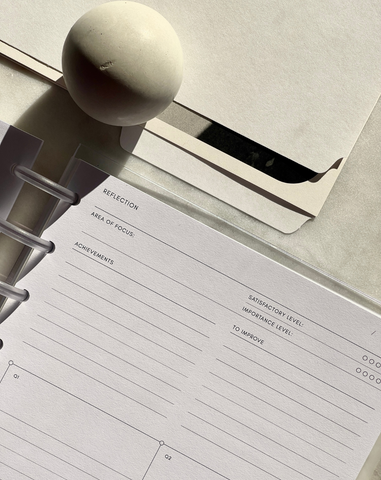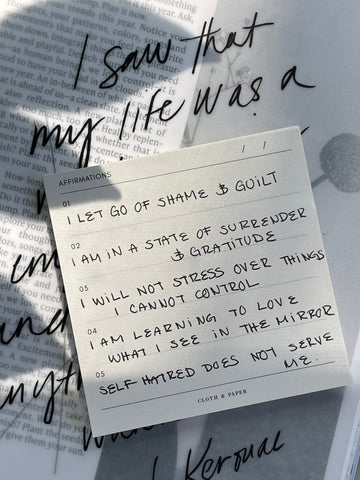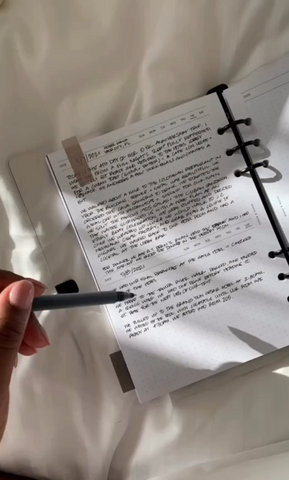5 Self-Care Methods to Try in Planning
Self-care is one of the planning community’s favorite themes, and this is not surprising! Self-care is defined as “the practice of taking action to preserve or improve one's own health,” or “the practice of taking an active role in protecting one's own well-being and happiness.” By this definition, planning in itself is a form of self-care: you’re actively preserving your time and mental wellbeing using organization and self-expression. We’ll be looking at five self-care methods that you can add to your planning to further your self-care journey!

Daily Gratitude
Expressing gratitude daily is a healthy habit for cultivating self-care and even improves the community around you. It is shown that it may lower stress, improve heart health, raise general happiness, and boost interpersonal relationships (Harvard Health). We recommend starting with inserts specifically tailored for daily gratitude, like the Daily Gratitude Log, or simple note-taking inserts like Task Planner Inserts, which can be used as a line or two-a-day, and Quad Lined Inserts, which provide four dedicated block spaces for writing. An alternative is using Mini Gratitude Notecards to either save for personal archiving or directly give to those you appreciate! Or, keep plain sticky notes such as Note Neutrality Stickies near your bedside, workspace, and relaxation area to write a line of gratitude when the moment arises. 
Since gratitude looks different for everyone, there are a few different methods you may want to try! Gratitude can be privately dedicated to a specific person, feeling, place, item, etc. Gratitude can be expressed religiously, in the form of prayer, or purely secularly. It can be relevant to just the current moment, or a distant memory. And, gratitude can be used for personal empowerment or to mentally give thanks for others. Remember that self-care is supposed to benefit you, so if weekly, monthly, or sporadic gratitude expression works better for you than daily, go for it! If you prefer to stick to a daily routine, set a reminder for a specific time everyday, or work it into your morning/evening routines.


Wind-Down Reflection
Reflection involves introspective consideration and analysis with the intention to grow. To put simply, it helps you create meaning in your life, which is integral to continuous growth and development (Jennifer Porter, Harvard Business Review). We have the tools to help you in this meaningful journey, and tips for mastering the process.
Consider using some note-taking inserts or a journal with the Daily, Weekly, and Monthly Reflection Dashboards – these provide prompts to get you started with your reflections. It is beneficial to start reflecting towards the end of the day, week, month, year, and after you have accomplished a goal or come across an obstacle. This way, the reflection process feels just as relieving as starting your evening routine after a long day. If using a blank sheet to start the process feels daunting, our 30-Day Journal is designed for you to both set expectations and reflect. Alternatively, the Mental Download Inserts layout is great for taking your reflections and digging deeper, whether through visuals or compiling.


Showering Affirmations
Similar to expressing gratitude, using affirmations is shown to improve both mental and physical health! The act of using affirmations, either verbally and mentally, is likened to exercising your brain, just as you may exercise physically to improve health. (Kimberly Hill, MSW, LCSW. Wellspring Prevention).
So, how can you implement this in your planning routine? Well, there are a few different methods to choose from:
- A popular method is writing your affirmations on a sticky note and placing it in clear view. Some people use mirrors, planners, phone cases, monitors, or boards to keep their affirming messages nearby.
- Another idea is to keep dashboards with affirmations towards the front of your planner, or in sections that you frequent. The Believe Dashboard reminds us to “Believe in Yourself.” The Harder I Work Dashboard provides a quote by Samuel Goldwyn: “The Harder I Work, the Luckier I Get.” Jack Kerouac reminds us on the Handwritten Dashboard that we can do anything we want with our lives. Or, add your own affirming quote to the Your Mind Believes Dashboard using a Circle Sticky Note, which fits perfectly within the design and can be swapped out whenever you need a change of inspirational scenery.
-
Are you looking to dig deeper and keep a log of your affirmations? Add the Mental Wellness Inserts to your planning routine to keep track of each affirmation, and how they can pair with your intentions.


Intentional Planning
Usually when we think of self-care, we think of pampering, journaling, coziness, and relaxation. Did you know that not all self-care is necessarily easy or fun? Consider chores and the not-so-easy parts of growth. Well, those still count as self-care! You are preserving your well-being and health by maintaining your environment, mental health, etc. Relatedly, sometimes a difficult part of planning is doing it intentionally — with the expectation of working towards a goal in the most beneficial and healthy way possible. Start with the simple steps laid out on the Intentional Planning Dashboard. The steps within the dashboard easily break down methods for working towards your goal and conquering the nitty-gritty each day. When you create goals or schedule tasks every day, write them with the full intention to complete them, starting with most urgent to least.

Intentionality is also important when it comes to planning physical goals. The thought of exercising exactly as envisioned can be exciting, but you may need a little motivation when it comes to execution. Using detailed notes, goals, and tracking with the Wellness Bundle turns your wellness goals from ideas to accomplishments and growth.

Freeform Journaling
Of course, we can’t leave journaling out of self-care planning! Journaling provides a space that is purely dedicated to you. Any thoughts, ideas, concerns, etc. are valid, and can be expressed with words, pictures, doodles, decorations, and any other items you want to bring to paper. The Journaling Inserts are the most convenient for incorporating journaling to your planner, but really you can use any insert, sticky note, or notepad available!
Expand on using journaling to activate different parts of your brain. Try spritzing your favorite perfume, or filling the page with your favorite color. Experience an amazing moment that you want to capture forever? Print and add a photo, or use the most relevant words and phrases that encapsulate how you felt in that moment. Each time you refer back to that page, you will be filled with the emotions you felt in that moment! Journaling is engaging with your truest you. It creates an archive of each version of yourself, and every era of your life that you can come back to and reflect on at any time.
The planning community reminds us how important self-care is in their planning journey, and we cannot agree more. We hope these tips help you cultivate your own self-care plan, and encourage those comforting feelings of wellbeing and happiness.
This content is not intended to be a substitute for professional advice or treatment. Always seek the advice of your mental health professional or other qualified health provider with any questions you may have regarding mental health.
Sources
Harvard Health. https://www.health.harvard.edu/healthbeat/giving-thanks-can-make-you-happier
Hill, Kimberly, MSW, LCSW. https://wellspringprevention.org/blog/the-benefits-of-positive-affirmations/
Porter, Jennifer. https://hbr.org/2017/03/why-you-should-make-time-for-self-reflection-even-if-you-hate-doing-it

Join us over on Cloth & Paper’s Facebook Insiders to be part of a community filled with like-minded individuals who are spreading positivity and sharing ideas every day!






















